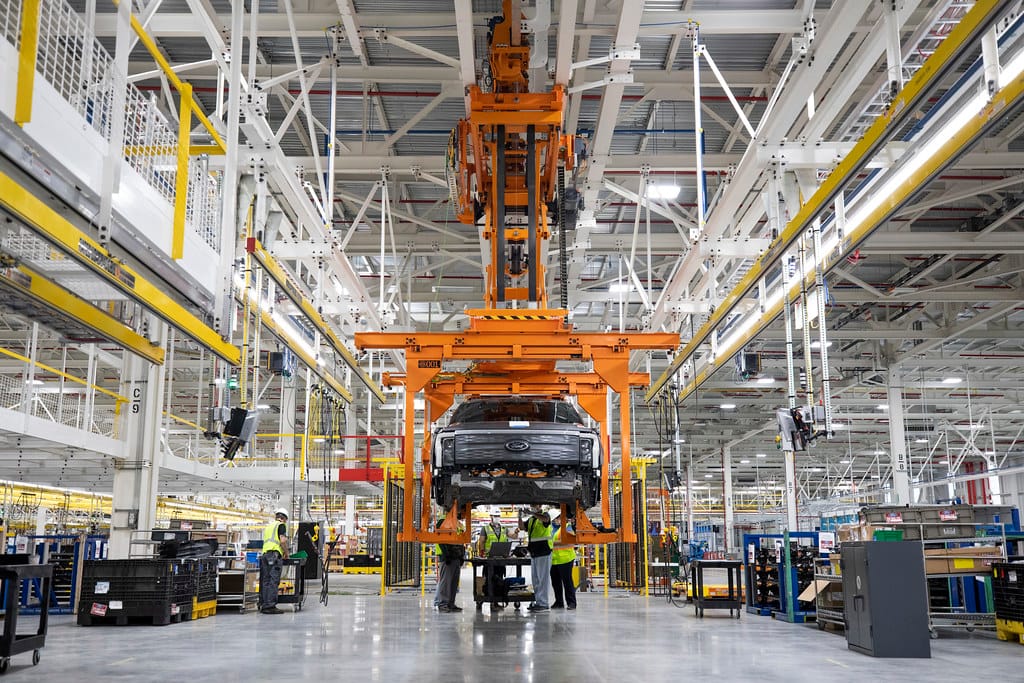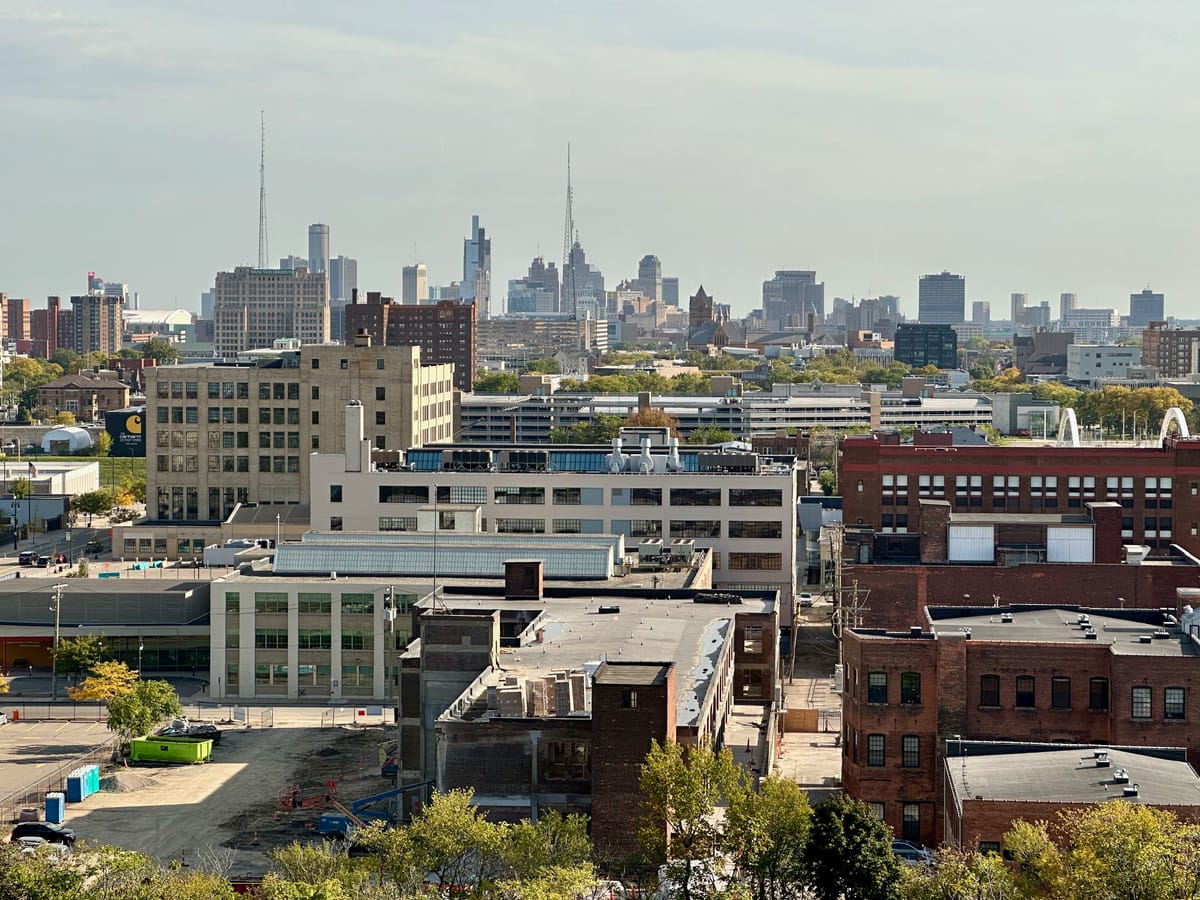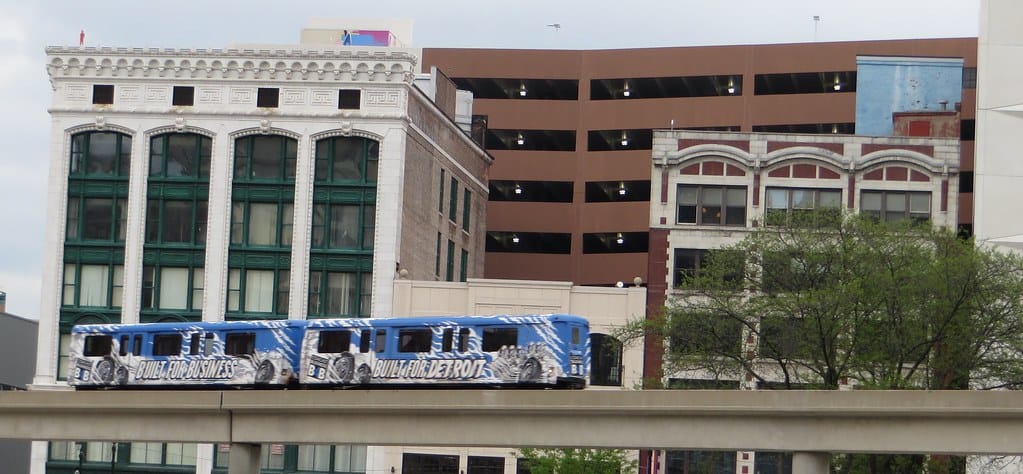I traveled to Los Angeles recently to cover the auto show and got to stay in a hotel in a familiar-looking building. You might recognize it from movies like “Strange Days,” “True Lies” or “Interstellar.” Or, if you’re a Detroiter, you might think, “what the hell is the RenCen doing set among palm trees?”
The Westin Bonaventure, located in downtown L.A., is kind of a smaller sibling to the Renaissance Center, both having been designed by architect John C. Portman. The Bonaventure opened in 1976, a year before the RenCen’s hotel opened — though technically, Tower 100 opened in ’76 as well. (There’s actually a third RenCen sibling as well: the 73-story Westin Peachtree Plaza in Atlanta, which also opened in 1976. It looks exactly like the RenCen’s central tower, only it stands by itself, without smaller towers surrounding it.)
 If you’ve spent any time inside the labyrinthine RenCen, the similarities with the Bonaventure quickly become apparent beyond just the space-age cylindrical glass exterior design. The first impression is that this is a much smaller version of the RenCen, about half as tall at 35 stories and less massive in terms of its footprint and overall scale. The basic layout is the same — four towers surrounding a central spire, just like the original RenCen layout (Towers 500 and 600, the twins to the east, were added later). And yes, there are glass elevators that run along the outsides of the towers.
If you’ve spent any time inside the labyrinthine RenCen, the similarities with the Bonaventure quickly become apparent beyond just the space-age cylindrical glass exterior design. The first impression is that this is a much smaller version of the RenCen, about half as tall at 35 stories and less massive in terms of its footprint and overall scale. The basic layout is the same — four towers surrounding a central spire, just like the original RenCen layout (Towers 500 and 600, the twins to the east, were added later). And yes, there are glass elevators that run along the outsides of the towers.
Step inside and you find yourself in a lobby with a soaring atrium with a glass ceiling looking up at the towers, with a broad fountain feature and a bar and Starbucks counter ringing the base of the central tower. One neat feature: The hotel appears to have some kind of arrangement with LAX to serve as official lodging for flight crew members. One night while visiting the front desk, I saw an entire crew of an Asian (Korean, I guessed) airline enter the lobby with their rolling luggage, all the female flight attendants striking in teal blazers, black skirts and pillbox hats.
 Just like the RenCen, there are ring-shaped concourses with floating pod areas branching off of them — though unlike the RenCen, these were simply empty spaces without seating. The first three floors are also a kind of self-contained indoor city, with ballroom and meeting spaces, retail stores, restaurants and so forth. It gives off a decidedly ‘80s shopping-mall vibe, especially with all the futuristic tube motifs.
Just like the RenCen, there are ring-shaped concourses with floating pod areas branching off of them — though unlike the RenCen, these were simply empty spaces without seating. The first three floors are also a kind of self-contained indoor city, with ballroom and meeting spaces, retail stores, restaurants and so forth. It gives off a decidedly ‘80s shopping-mall vibe, especially with all the futuristic tube motifs.
The RenCen has a little of that, too, but less so since General Motors renovated the place after buying it in 1996. Ed Whitacre, who served as GM’s CEO during its bankruptcy reorganization, famously wrote that “The RenCen was the perfect metaphor for General Motors: overblown, overdone, complicated to the max.” The Bonaventure can also be tricky to navigate, but it’s not quite as bad — largely because it’s simply smaller, with less space to get lost in. But maybe it’s because I more or less know how to find my way around Portman’s cylinder and ringed concourse concepts by now.
 It’s interesting to compare how the RenCen and the Bonaventure are viewed in their respective cities. The RenCen has been criticized over the years for being hard to navigate and for being separated from the rest of downtown by the former berms that acted like a wall between the building and East Jefferson. Free Press columnist John Gallagher wrote: “In terms of architecture and urban design, Portman’s Renaissance Center — four 39-story office towers surrounding a 73-story hotel built for $350 million in 1977 — created as many problems as it solved.”
It’s interesting to compare how the RenCen and the Bonaventure are viewed in their respective cities. The RenCen has been criticized over the years for being hard to navigate and for being separated from the rest of downtown by the former berms that acted like a wall between the building and East Jefferson. Free Press columnist John Gallagher wrote: “In terms of architecture and urban design, Portman’s Renaissance Center — four 39-story office towers surrounding a 73-story hotel built for $350 million in 1977 — created as many problems as it solved.”
The Bonaventure, by contrast, has been highly sought-after setting for many a Hollywood director — and legendary failed automotive entrepreneur John DeLorean, who had his DMC-12 gull-wing sports car photographed in front of it in 1978.
 “From day one, the Bonaventure was a perennial favorite utopian paradise/dystopian nightmare, yet it’s managed to become a grudgingly loved part of the L.A. backlot,” L.A. Weekly wrote about it in 2016.
“From day one, the Bonaventure was a perennial favorite utopian paradise/dystopian nightmare, yet it’s managed to become a grudgingly loved part of the L.A. backlot,” L.A. Weekly wrote about it in 2016.
“Almost every weekend you’ll see car commercials shooting in the streets alongside the hotel, shiny new vehicles accelerating under the raised pedways that link to it, the early stages of a failed 1970s plan that nevertheless looks great to sell next year’s model.”
I don’t know anything about that failed ‘70s plan, but I’m guessing it might have something to do with the drawbacks of its immediate surroundings, which I discovered one night when trying to find a restaurant that Google Maps told me was a mere two blocks away.
The problem: Two of the streets that bookend the Bonaventure come to a dead end at a parking structure right across the street from the hotel’s entrance. Except they don’t, because those streets have upper decks that allow them to cross over the nearby 110 freeway. But this isn’t at all clear from street level at the Bonaventure’s front doors. Confused, I asked someone for directions, and was told to take the elevator to the top of the parking garage, walk around the plaza outside the YMCA at the top of it and then find the street I was looking for. Weird.
So in that way, both buildings are in some ways strange fits for their urban environments.













